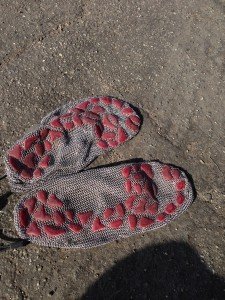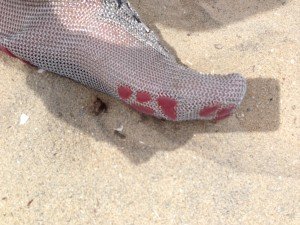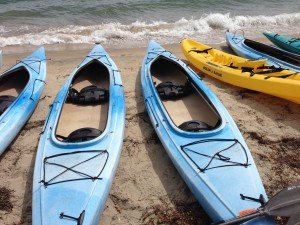Last year I wrote a review of, and made some videos about the PaleoBarefoot chain mesh shoes from GoSt Barefoots. At the time I noted that they’re great for running off road, particularly on ice, sand and other natural surfaces. I really couldn’t imagine a more suitable shoe for those surfaces, but they were limited by the fact that they really couldn’t be used well on hard surfaces such as tile, wood, or shiny slippery surfaces. This meant that if you wanted to use them for watersport, they were great unless you were on a boat or dive platform etc. Well, they found a solution, and it’s really quite amazing.
When you see dogs and cats run around, even jumping up onto slippery surfaces, they maintain grip really well, due to the structure of their paws. This idea has now been taken and applied to the PaleoBarefoots. By applying small areas of a smooth, flexible, but very durable resin to the sole of the Paleos, you achieve the same sort of feel and properties as the original Paleos but with the added benefit of amazing grip on slippery surfaces.

One of the other benefits is that because the PaleoBarefoot Paws only cover small areas the full flexibility of the originals is maintained, but the shoe overall is lent some structure by their distribution and shaping.
Since I already know that the Paleos are great for all sorts of running and general ‘off-road’ use, I decided to try them out with a sport where I’d previously found them not to be ideally suited, because of the slippery surfaces involved – Kayaking.
I’m privileged to occasionally volunteer with a wonderful San Diego Organization called “Outdoor Outreach“, who help at-risk and underprivileged youth by taking them out to teach them things like surfing, kayaking and rock climbing. Since getting hold of the Paws coincided with going out Kayaking on an Outdoor Outreach expedition, I decided that this would be the perfect test opportunity.
As with the regular Paleos (and if you have those you can send them in for adding the Paws should you want to) they performed perfectly and very protectively on the beach area as we were unloading the kayaks, and in helping launch the kayaks off the beach. This is an activity where conventional footwear becomes completely sodden and clogged with sand – as everyone else who was wearing regular shoes quickly found out! As soon as I hopped into the kayak (which has a slippery surface on the inside) my feet started to dry out nicely and all the sand just washed through – this is one of my favorite things about the Paleos! The grip was great, and I had no problems with the surface or using my feet to provide stability and grip while paddling.

We had a great paddle around the beautiful San Diego harbor, where you can see California harbor seals, sea-lions and all sorts of interesting ships and submarines – even occasionally dolphins although we didn’t see any this day. The youth we were with had a lot of fun learning to navigate kayaks and enjoying the view. My feet in the Paleos were very comfortable throughout. No chafing or coldness because they just dry out fast if they get wet, and your feet stay at the ideal temperature.
One other nice thing about the Paleos is the amount of attention and comment they get! This was particularly so when we returned. Imaging getting out of a kayak from the sea (hint, you have to navigate through waves and you will get wet!) then jumping out of it onto wet sand, and pulling it up the beach. In conventional shoes, you will end up with shoes completely clogged with wet sand – and everyone did! They could see that the Paleos just stayed clean, anything that gets on them just flows through and they start to dry out immediately, which keeps your skin comfortable. They’re also made of metal, which everyone thought was cool! I got a lot of questions about the comfort, but they could feel that they are very smooth and could see I had no problem wearing them for several hours, in and out of the water, and once they compared them with their own wet, sandy sneakers, they could see the benefits!

I’ve also tried these out around the house, for instance on tiles and polished wood floor, and the grip is really good, but these shoes are meant for being outdoors and exploring nature, and they’ve really made so many situations possible where barefoot would be dangerous or almost impossible. The fit and comfort is great, and in my opinion, because of the added structure the Paws provide, they seem to stay in place even better than before.
You can check out more about the GoSt PaleoBarefoots on their website.
